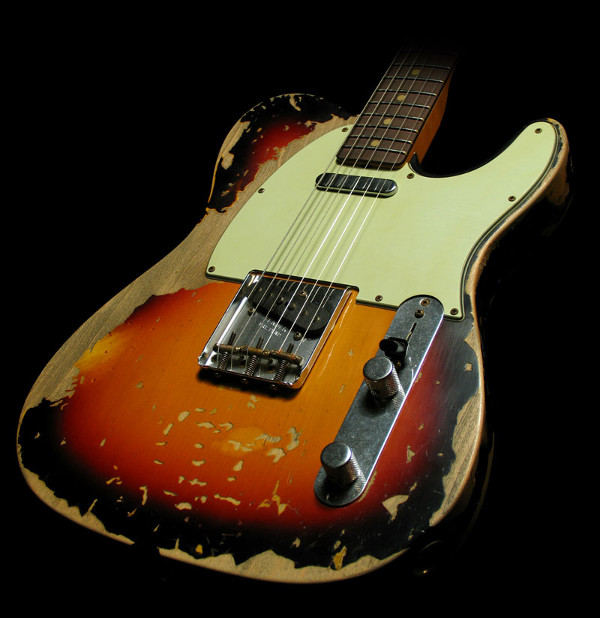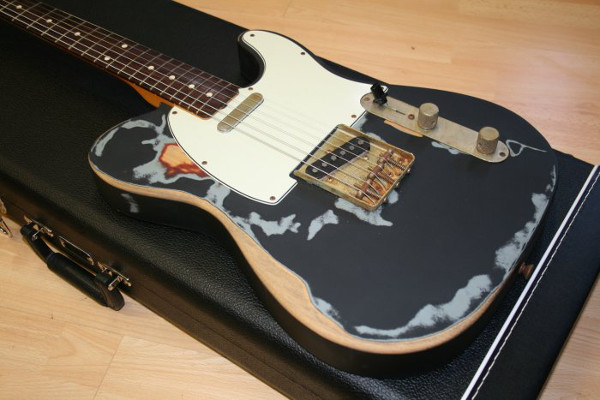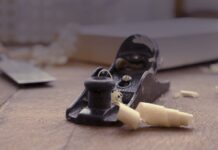Do you play guitar, or do you just love the instrument? If so, have you come across the trend for custom guitars? It’s often called ‘relicing guitars’, and it’s a hot topic that’s been fascinating guitar owners, players, collectors and lovers for a number of years.
Directly in line with the current fashion for shabby chic interior décor, ageing guitars is all about making new or relatively recent instruments look like beautiful old, used and well-loved vintage guitars. The idea is to make the instrument look like it’s been heavily used for forty or fifty years, and the effect is often called ‘road worn’.

As the Telecaster Discussion Page Reissue (TDPRI) states:
“Because of the expense of buying a beat-up vintage Tele, guitar manufacturers decided in the ’90s to ‘recreate’ the look and feel of 40 years of use on brand new guitars. Relics, as Fender branded them, were an instant success – and an instant controversy. For many they are completely wonderful, for others they are complete heresy. “Why beat up a brand new guitar and then charge more for it?” seems to be the main sentiment, but for many others, it just makes perfect sense. Naturally, if the factory can do it then the DIY market can do it better.”
The trend was given a boost at the infamous Dallas guitar show back in 2006, where a demo was carried out by the legendary Fender Custom Shop. You can read all about the demo in fine detail via the link above, where there’s a step-by-step guide showing the demonstrator using a tinted wood stain to help age the instrument to perfection.
Original vintage guitars from the 1950s and ’60s can sell for tens of thousands of pounds, because of their historical value as well as the lovely, aged finish. A genuine relic Stratocaster is a highly desirable object, far beyond the pockets of most people. A real road worn Telecaster is a seriously costly item. New road worn guitars usually cost more than standard guitars. But they’re still a lot less than the ancient originals, which are worn naturally over many decades.
Obviously a Fender relicing job is an expensive business when carried out by the masters themselves. But you can do it yourself, making beautiful, old-looking guitar bodies, necks and fittings with a little confidence, creativity and the right wood finishing materials.

How to Relic a Guitar – Guitar Relicing 101
You might not want to practice on a guitar you love, just in case it goes horribly wrong! You can pick up cheap second hand guitars at junk shops, antique emporia, charity shops or online and hone your skills before letting yourself loose on your favourite instrument.
Does relicing a guitar change the sound?
Because the body material and the pickups remain the same, the sound of your guitar shouldn’t change. If it’s a cheap model, sadly it won’t sound any better. Upgrading the pickups to more ‘rustic’ or ‘vintage’ sounding ones will give your guitar the look and sound of a killer axe but is entirely optional. On the positive side, you won’t ruin the sound of a good quality guitar that just needs a touch up or adding your own customisation to it.
DIY Relic Guitars – Step 1 – Making the Wood Look Old
The guitar body, neck and the headstock are easy to age. Manufacturers do it by enhancing the varnish’s ‘fraying’, usually with a very fine grit sandpaper. It’s simple, but you need patience.
Where do you carry out the distressing? Natural wear occurs wherever the act of playing, storing or transporting the instrument causes damage. There are plenty of images online, or you could make a note of the effects your own style of playing has on various areas, for example:
- where your hand rests on the body
- where your fingers habitually rub the neck
- either side of the strings (although not below them)
- the lower part of the guitar, where your arm rests when strumming
- just below the pickups, where your pick wears the lacquer away
- around the control buttons
- on the neck, between the frets
Before you begin, take all the metal parts off and, if at all possible, remove the neck altogether.
Most instruments are coated with polyurethane lacquer, some are coated with nitrocellulose, which is thinner and helps the guitar resonate. You need to remove the varnish in the places you want to create wear. Both types of finish are sensitive to sunlight and temperature differences, so you can stand the body in sunlight after you’ve carefully sanded the surface. When it’s hot, cool it down as quickly as you can. A freezer is ideal if yours is big enough. Then repeat the process until the finish starts to crack.
Alternatively, simply heat the parts of the body you want to look old with a hair dryer then cool it fast with a compressed air spray. If you hear a crack, don’t worry. It mean the process is working as it should. Just bear in mind it’s a bad idea to do this with the neck attached because you might bend it, which could be potentially expensive to fix. Be wary of acoustic guitars where the neck is fixed, so you might want to skip this step when aging an acoustic guitar.
When you’re happy with the level of distressing, rub the instrument down with a damp cloth. While the un-lacquered parts will soon get grubby through natural wear as you play, you can use a dirty cloth to give the finish instant personality.

Creating a Road Worn Guitar – Step 2 – Distressing the Metal
You don’t have to distress the metal parts. But it goes a long way towards creating an authentic relic look. Firstly, remove them from the body. Then get busy creating damage. You can hit the parts with a brick or stone, or even concrete, to pit the surface and create a key for dirt to accumulate. Scratches are also good, exposing the metal underneath the shiny plated finish.
You can also rub the shine off with either a fine metal file, wet sandpaper or steel wool, check out our range of abrasives for more information on sanding and abrasive materials. If you want to take things further for a more dramatic look, you can dip them in bathroom cleaner, which is abrasive and often acid, and eats away the surface beautifully. Remember to check progress regularly so you don’t go too far. Twelve hours isn’t uncommon, so exercise patience. When it’s done, simply rinse the parts with soap and water.
Relic Guitar Creation – Step 3 – Distressing the Plastic
This is the easiest bit. Take the plastic parts off the guitar body first, including the pick guard and pickup covers if you like. Then make random scratches and marks with a pair of scissors or a screwdriver to create places where dirt can accumulate.
Most pick guards have two or three layers, usually in different colours. So filing or sanding down the top layer will reveal the layers below – an enormously satisfying process.
White plastic looks great when it goes yellow – a sure sign of age. After sanding the surface you can get the effect with a small amount of dark solvent-based wood stain, such as Morrells Light Fast Wood Stain. Dot onto a cotton rag or paper towel. Clean off the excess with a clean cloth to leave a subtle stain that sits in the scratches you’ve made. Then add a coat of Morrells Nitrocellulose Spray Lacquer to seal in and complete the yellowing process. An amber colour is normally a suitable shade for ‘many years of grime’ look.
Leave everything to dry for a couple of days to make 100% sure it’s ready, strong and durable. Then re-assemble your instrument and you’re ready to play.

How far can you go?
You can be as subtle or extreme as you like. You can go your own way and get creative, or take a leaf out of Stevie Ray Vaughan’s infamous book and create a copy of his knackered-looking and highly desirable, beat-up Number One Stratocaster, which looks so worn it’s amazing it still functions. But as we said, the look doesn’t affect the sound. In fact wear often delivers that unique personality that so many guitar lovers envy.
You can make your own relic-ed Strat or a relic Les Paul, distress an acoustic instrument or age an electric guitar, create guitar bodies with subtle or dramatic wear… The world is your oyster and once you get the basics under your belt, it’s immensely satisfying. People make a great deal of money out of it, and it may even provide you with an extra income if you discover a hidden talent for making new and boring-looking models look just like vintage guitars.
How to Age a Guitar – 7 Top Resources
Here are some really good resources to help you create something special:
- How to Relic a Guitar – An excellent YouTube video
- A great guitar relicing website dedicated to the subject
- How to age an electric guitar
- Wikihow on guitar relicing
- A great article about why to relic your guitar
- And finally, to whet your creative appetite, the absolutely inspirational Fender Custom Shop site, including galleries and collections, a shop and a section on master built masterpieces. The real deal from Fender’s craftsmen costs a fortune. But you can learn how…
Need help creating your own epic custom guitars?
For more information about guitar finishes and their uses, contact our team of resident experts who are always on hand to help with project advice and product recommendations. Alternatively, visit our FAQ page.We love also to see before, during and after photos of any wood finishing project. If you would like to share your DIY relic guitar pictures with us, you can either send us some photos or share on our Facebook, Twitter, Pinterest or Instagram pages.





Planning to do this to my flying V. Thank you for the article! Super helpful!
Great article, very informative and the added links are a bonus.
Thanks I now have a pet project to keep myself busy and a head full of ideas.
Is it the same process on acoustic guitars?
Hello Josh,
It very much depends on the build, wood and current condition of your guitar. If you would like to email in with some further details we may be able to offer some help, however it is a very specialist area and not something that we are experts in. I am aware that there are many You Tube Videos available for such projects.
All the Best Samantha.
Do it yourself that is the fun part and then it really is your guitar.
I’m interested in getting my stratocaster reliced. Can you direct me to someone who might do this for me? I’d be willing to mail this to any location in order to achieve it.
Thank you,
Jack O’Halloran
316-650-4837
Hi Jack,
Really sorry Jack but this is not our field of expertise. You could try a google search and see if anything comes up. Hope you find what you are looking for.